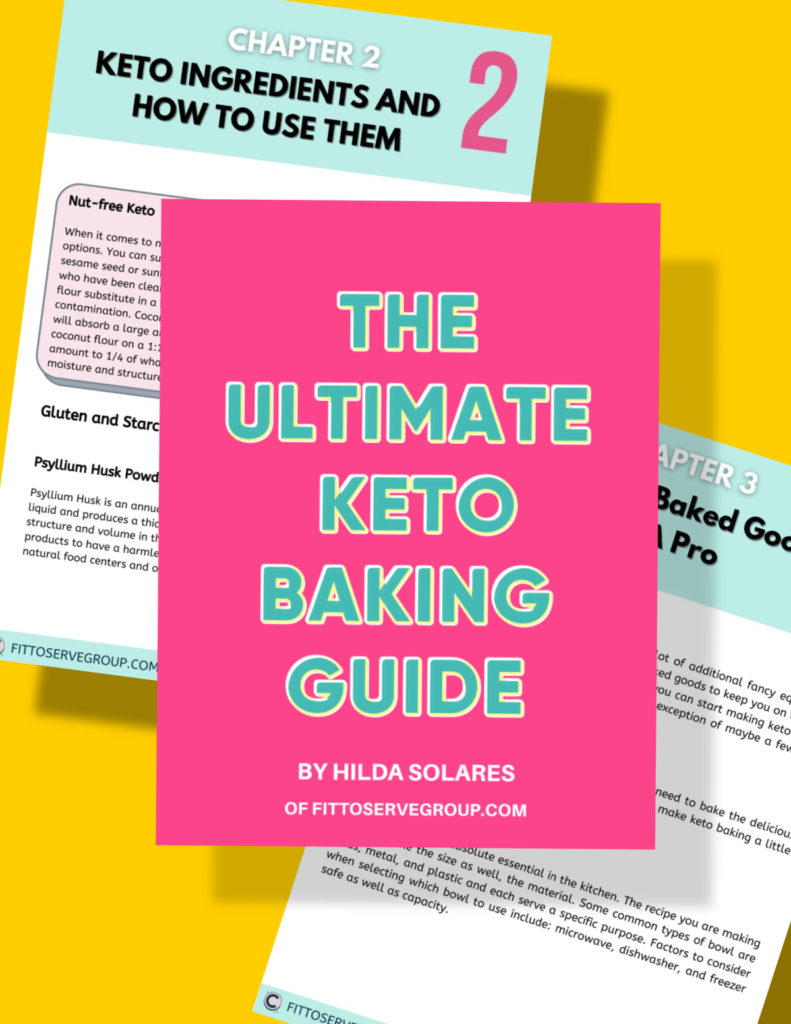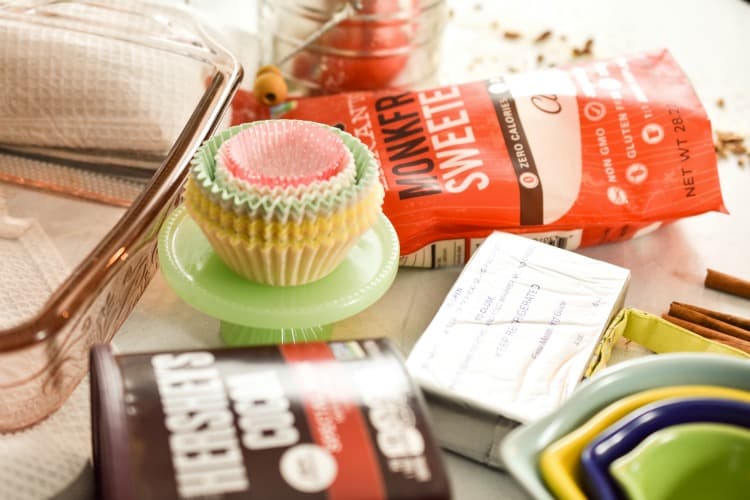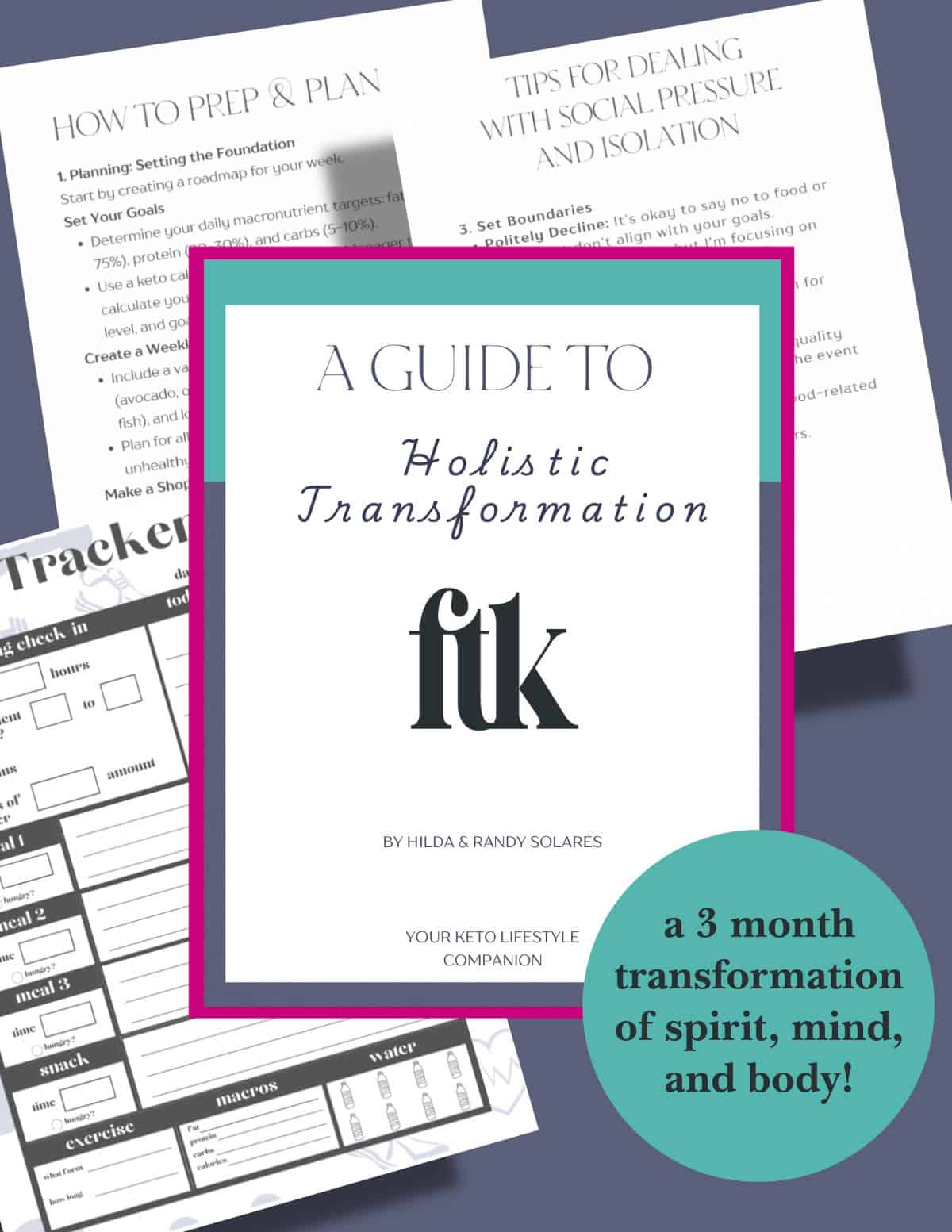Are you ready to start keto baking but have no clue where to begin? My ultimate keto baking tips are perfect for both experienced and inexperienced bakers.
Ketogenic baking can be intimidating, especially if you have no baking skills or are used to baking with wheat flour and sugar-based recipes.
Unfortunately, low-carb baking is not as easy as swapping low-carb ingredients for high-carb ones.
Learning how to create keto baked goods will make the ketogenic lifestyle much easier, so it's worth the time and effort.
Low-Carb Baking
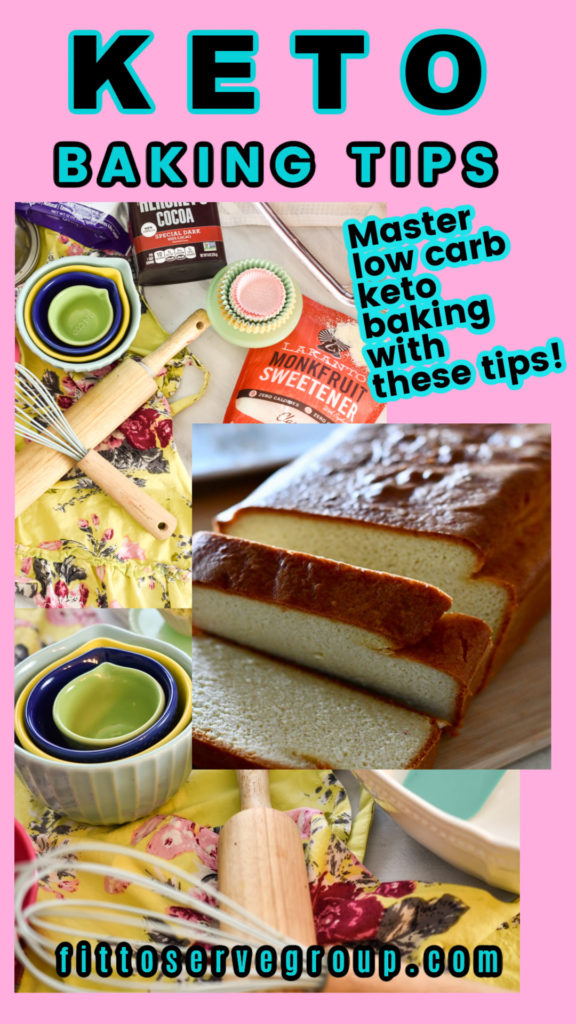
What's more, baking keto can take less time. As an example, you will not have to proof your bread the same way you would with gluten-based recipes that use yeast as a starter.
Another plus is that keto baking uses nutrition-loaded ingredients like real butter, cream, nut flours, and high-fiber options like coconut and flax meal.
These ingredients are far superior to sugar and white all-purpose flour, both of which are void of nutrition and are simply empty calories.
Baking Tips For Keto Bakers
Does this sound familiar? You decide to do a keto diet, and you are excited about all the possibilities this decision will bring. So you toss out all your high-carb baked goods from your pantry.
But a quick trip to the grocery store proves to be an eye-opening experience when you discover that there is a great shortage of low-carb baked goods on the shelf.
"What are you telling me? There aren't any keto cakes, bread, or cookies for me to easily purchase?" But there's a whole section of gluten-free items. "Surely some of those are also low in carbs and keto-friendly?"
That was my experience when I first began my low-carb journey. I quickly realized that if I was going to do keto successfully, I was going to have to learn how to keto-bake.
But how hard can it really be?
Well, I am here to tell you that it can be very challenging if you don't know the basics.
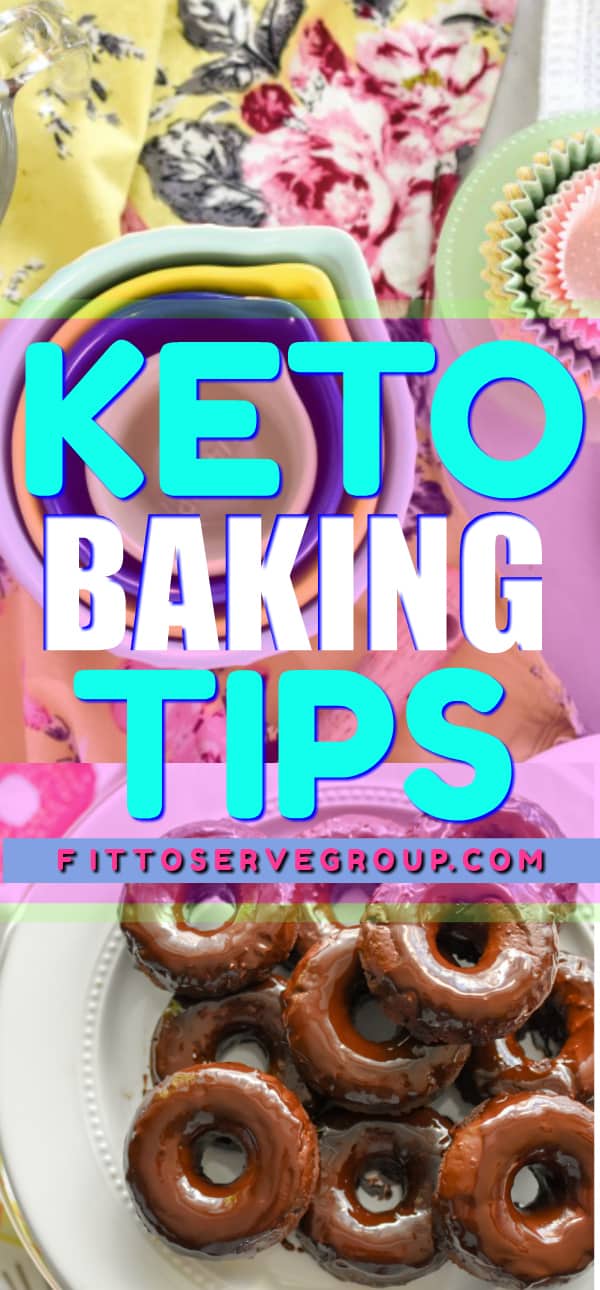
Trust me when I tell you that I know firsthand how even an experienced baker can be intimidated by keto-baking recipes. Frankly, I was there, and it wasn't fun. I was crushed when my first attempts ended in the trash.
I mean, who wants to toss a bunch of expensive low-carb baking items after countless failed attempts? Not me, and I doubt you want this, too.
Because I was there, I don't want you to make the same mistakes. So, with that in mind, I am going to share my tried-and-true keto baking tips with you.
You see, there is a true science behind baking, and keto baking is no exception.
Every time we bake, we are creating a little science experiment in our kitchens. But when we embark on baking with keto ingredients, that experiment can fail epically if we don't understand how these unique ingredients interact with one another.
Practical Baking Tips
Keto baking can be quite intimidating if you are accustomed to conventional flour recipes. While it's impossible to 100 percent mimic high-carb goods, we can come rather close.
The lack of gluten in keto baked goods means that the texture will certainly be different from gluten-based goods. It will be trickier to achieve a chewy or crispy texture, which means you will have to use certain ingredients and techniques to come as close as possible to their conventional counterparts.
Keto baked goods also tend to be a bit denser in texture, and that's why they normally call for more leavening agents.
The good news is that I am confident that after you've had a chance to implement my ketogenic baking tips, you will be able to consistently create delicious low-carb baked goods.
Grab your apron; this keto baking class is in session!
My advice is to pin this post for reference and refer to it before you do any ketogenic baking.
I've noticed there are two camps of people who follow the keto lifestyle. You have those with prior baking experience and those who have never baked from scratch.
This simply means that those with zero baking experience will need to learn some basic baking skills, and those who are experienced bakers will need to adjust their baking habits.
So, whether you are a seasoned baker or have never picked up an item from the baking aisle, you have some learning to do when it comes to baking on keto.
Ingredient List
My number one piece of advice is that before attempting low-carb baking, do not try converting your own high-carb baking recipes; instead, stick to recipes that have already been developed using these flours and ingredients.
This way, you can avoid tossing a bunch of keto ingredients while you learn.
But keep in mind that even if you are attempting keto recipes that are popular in the ketogenic lifestyle, you still need an understanding of the basics.
Once you successfully implement these keto baking tips, you can then start converting your own family's favorite recipes.
While you learn, I encourage you to try a few of my easy keto-baked recipes.
A good place to start is with my Keto Cream Cheese Pound Cake. There is a reason it's so popular, mainly because it does not require too many steps or hard-to-come-by ingredients.
With that being said, keep in mind that no matter how good a keto baking recipe will be, using low-carb flour and sweeteners will not give you the same exact results as traditional recipes. However, you can come pretty close.
Keto Flour
Disclosure: Some of the links below are affiliate links, meaning, at no additional cost to you, I will earn a commission if you click through and make a purchase.
Let's begin this keto baking lesson by choosing the right keto flour substitute. It's important to note that wheat flour will always be finer and lighter than any alternative low-carb flour.
The main reason they don't behave the same is that keto-friendly flour does not have gluten in it. The chewiness that wheat flour provides will not necessarily translate into a low-carb baked good because it lacks gluten.
In addition, low-carb flours tend to spoil rather quickly; this is why I recommend that you store them in airtight containers and don't plan on keeping them for very long.
Keto-Friendly Flour
This is where things can get a bit confusing. There are many low-carb choices, and it can get overwhelming when you are new to this way of baking.
Each low-carb flour alternative acts differently. So, based on what you are trying to convert, you must choose the one that works best for that particular type of baked good.
It's been my experience that almond flour is the easiest of all the low-carb flour to work with. Generally, almond flour is my go-to choice for low-carb cakes, muffins, quick bread, and cookies.
However, the ratio of almond flour called for will depend on the recipe you are making. A cake recipe will not call for the same amount as, say, a cookie recipe.
Plus, swapping almond flour for wheat flour is not an automatic 1:1 ratio. Why? Because you are dealing with a nut that has been ground. Nuts are high in fat and moisture and void of gluten.
What's more, the texture of wheat flour is much finer and drier than that of almond flour. This is why good keto baking recipes will consider this.
If that's not enough, almond flour weighs much differently than wheat flour. Sometimes, depending on the brand, there could be more than an ounce of difference.
You may want to invest in a kitchen scale to ensure you are measuring your ingredients correctly.
Almond Flour Versus Almond Meal
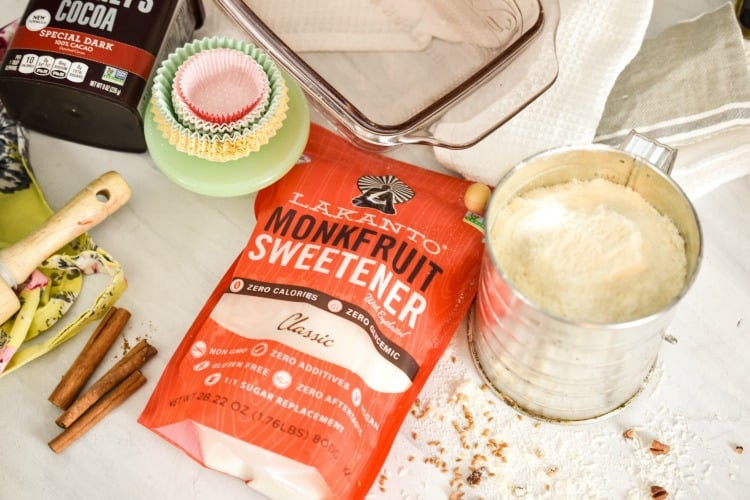
If you've ever attempted to buy almond flour or almond meal, you may have noticed a few differences between them.
Almond flour is lighter in color and texture. At the same time, almond meal has flecks of brown in it. This is because almond meal is made from almonds that have not been peeled.
In the case of almond flour, they are ground much finer and without their skins. The almonds have been blanched to remove their skins before grinding. That's why you do not see any brown specks in the flour.
You may have also noticed that there is a significant price difference between the two. This is because it's more labor-intensive to produce almond flour since it has to go through the blanching process first.
Keep in mind that, in addition to their differences, almond flour and meal brands will vary from brand to brand. My personal favorites are Anthony's and Bob Red Mills.
You'll notice that some keto baking recipes call for your almond flour to be sifted. This is something I personally recommend in the majority of my recipes.
Sifting your almond flour will help the texture be finer and will act closer to wheat flour. When I sift my almond flour, I do so after I have measured it.
Note that the almond meal will prove to be too heavy and grainy for most of your baked goods.
I use almond meal in my keto cornbread because its texture can mimic cornmeal in keto baking, but you won't really see me mention it anywhere else.
Coconut Flour
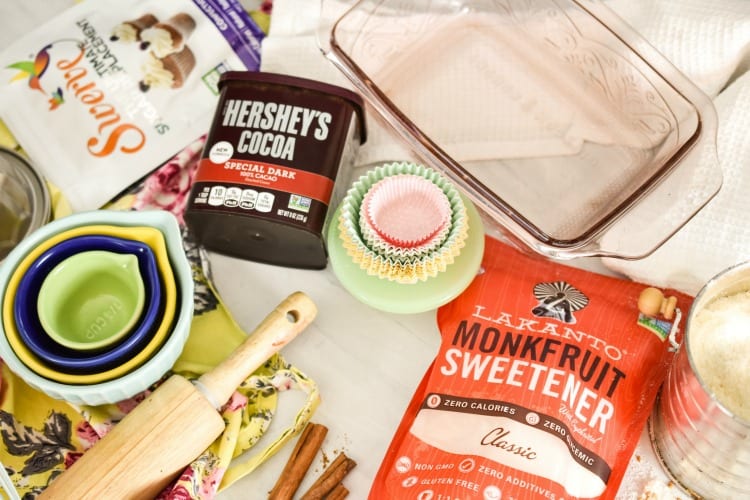
Coconut flour is actually a by-product of coconut milk when it's being produced. Once the coconut milk has been extracted, what's left is coconut meat.
The coconut meat is then dried and finely ground. This creates a fine powder that looks a lot like wheat flour.
The biggest difference between wheat flour and coconut flour is its dryness.
Coconut flour needs lots of moisture in the form of liquids and/or eggs to be used as a wheat flour alternative. Because coconut flour is quite thirsty, it cannot be substituted for flour, cup for cup.
Finding the right balance of liquid when using coconut flour can be tricky. If you use too much liquid or eggs, you end up with a soggy mess; if you use too little, it won't come together correctly.
Just because baking with coconut flour isn't as easy as other low-carb flour doesn't mean you shouldn't attempt to do so. For those allergic to tree nuts, coconut flour can be a great option.
When you first start using coconut flour, it may require more trial and error, but when used properly, it makes a great substitute.
Remember that you cannot swap coconut flour 1:1 for almond flour. This is why you will notice that recipes that call for coconut flour usually use a smaller quantity.
Of all the flour alternatives, it can be the trickiest to work with, but once you learn how to do so, it produces excellent recipes.
The reality is that if you want to swap out almond flour for coconut flour, you will have to completely change the entire recipe.
I've also noticed that the quality of coconut flour also varies depending on the brand. My favorite coconut flour brands are Anthony's and Bob Mills.
Golden Flax Meal
Flax meal is made by simply grinding flaxseeds to produce flour. It can be used well in low-carb baking recipes, but keep in mind that it's a heavy flour. This is because it's a little more challenging to grind the flaxseeds fine.
Keep in mind that you want to use golden flax meal, not regular flax meal, in your recipes. Regular flax meal tends to have a gummy texture when baked, so it's a no-go, in my opinion.
Flax eggs are a common substitution for vegan recipes or for those who are allergic to eggs.
Some people also use flax meal to substitute eggs in a recipe because their texture thickens to a gel-like consistency when water is added.
Keep in mind, though, that If a recipe is mainly an egg-based recipe, this substitution will probably not work.
To replace 1 egg, mix 1 tablespoon of ground flax meal with 2 ½ tablespoons of water and allow it to thicken for about 5 minutes. This mixture can be used to replace the eggs but it will not act exactly as eggs do.
Hazelnut Flour
Hazelnut flour, sometimes called hazelnut meal, is made by grinding whole hazelnuts. It is considered a meal rather than flour since the skins are left intact during the grinding process.
Hazelnut meal has a rich, sweet, nutty flavor and is a bit denser in texture than, say, almond flour. It is an option that is high in unsaturated fat and is an excellent source of fiber and protein.
Hazelnut flour can be a great substitute for almond flour. Some people prefer this low-carb keto flour because it tends to be less grainy and produces a finer product.
Would you like to save this?
It is especially lovely in cookie and cake recipes. However, it can be the priciest of all low-carb flours since it's not as commonly used.
Sunflower Seed Flour
Sunflower seed flour is produced by grinding sunflower seeds finely into a powder. It can be a good low-carb flour alternative if you are allergic to nuts.
The taste of the sunflowers is pretty pronounced, so it may require using different brands to see which one you like best.
Sunflower seed flour is great because it can be ground finely. If you have a good blender, you could even make it at home. It can be substituted one-to-one for almond flour, making it a great keto-baking option.
However, it does have one negative: It tends to turn a shade of green when baked. This is due to a chemical reaction with baking powder or soda. This doesn't affect the flavor, but it may not be as appealing to the eyes.
To avoid this, add a tablespoon of apple cider vinegar or lemon juice to help counteract this reaction.
Sesame Seed Flour
Created by grinding sesame seeds finely, sesame seed flour is another great nut-free option. It is a little harder to come by and may require you to make your own by grinding it at home. I've also noticed that not all brands are created equal.
Although it can be used in place of almond flour, personally, it has a strong taste, so I would only recommend using it when you have other flavors to help mask this.
Understanding Sugar Substitutes
I have several recommendations for which sweetener you can use in keto baking. Currently, my personal favorite is Lakanto Monk Fruit. This is because the texture is close to sugar, and it barely has an aftertaste.
I'm also partial to Swerve, an erythritol/oligosaccharides blend. However, it does have a cooling aftertaste that some people dislike.
You could also use a stevia and an erythritol-based brand called Pyure. But for some reason, I find that stevia alone sweeteners tend to be quite bitter but that may not be the case for you.
Since it has a strong after-taste, in my case, you never see me mention it in my recipes. However, if you are a fan of stevia, you can use it.
If you use a stevia/erythritol blend, you will need to use ½ the amount of sweetener listed since it is doubly sweet.
Keep in mind that if your recipe calls for a confectioner's sugar substitute, both Lakanto, and Swerve have great ones that I highly recommend.

You can also grind your granulated sugar substitute in a dry coffee grinder and get good results, although the process is a bit tedious. I prefer the pre-made ones.
And if what you need is a brown sugar substitute, then I recommend Surkin Gold plus Lakanto Golden
If you're wondering if there are any good low-carb substitutes for maple syrup, I suggest Lakanto Maple syrup.
I am also a big fan of allulose sweeteners. Allulose is a monosaccharide. It has 90% fewer calories than sucrose, which makes it virtually calorie-free. Keep in mind it is about 70% as sweet as sugar so you may need a little more if you are hoping for the same level of sweetness.
Lastly, if you can't easily find a more natural sugar substitute, you can also use Splenda with great success.
I know not everyone would agree with me here, and I respect that, but in my book, it's still better than regular sugar.
Gluten And Starch Alternatives
One of the things I miss most about traditional baking is how predictable gluten and starch are in a recipe. The gluten in traditional flours gives baked goods structure, and it helps bind them together.
Trying to replicate these qualities with flours that have no gluten can sometimes prove to be a challenge.
A solution is to add whey protein or binders like xanthan gum, psyllium husk, gelatin, cream cheese, or extra eggs.
Psyllium
Psyllium is simply pulverized psyllium husk shells. In keto baking, this fiber is used to give more of a bread-like texture to your baked goods. I can see how I use it in my keto high-fiber breakfast bread.
However, since it is very high in fiber, it is commonly used as a laxative. Having more fiber in our diet is a good thing, but if you have a sensitive stomach, you need to keep that in mind.
Psyllium is used in keto baking to mimic gluten. When it's added to liquid, it forms a gel-like substance.
When added to a liquid, it turns into a gel-like substance. It works a bit like gluten in traditional baking and allows for handling the dough when rolling or shaping it.
Again, psyllium powders vary significantly from brand to brand. This is why I recommend NOW brand. Another factor with psyllium powder is that some tend to turn purple when baked. Which is not exactly what you are going for.
Xanthan Gum
Xanthan gum is a binding agent. It's what gives your toothpaste its jelly consistency. In keto baking, it's used to replace gluten. A little goes a long way with xantham gum. Otherwise, your baked goods will have a slippery mouthfeel.
Whey Protein Isolate
It is commonly used in many keto baked goods. Mainly because it helps with the rise. Since some whey protein isolates are quite high in carbs, you want a brand like Isopure's Zero Carb Unflavored.
Gelatin
You may also notice that some low-carb baking recipes use gelatin. That's because it helps give baked goods structure and a chewiness factor. You can see an example of a recipe that is used with our Keto Chocolate Chip Cookies.
Collagen
Adding a few tablespoons of collagen to my keto baking can also add a chewy factor similar to gelatin. However, I recommend you know the brand of collagen since some of them have a pronounced chicken flavor, and the majority of products made from collagen use chicken parts.
Here, again, is an example of not all brands being created equal.
Baking Powder
When it comes to baking powder and searching for keto-friendly options, you will need to check your labels carefully. The reason is that baking powder is basically just a mixture of three ingredients.
The ingredients are baking soda, cream of tartar, and starch. The inclusion of starch is where some people, who need to watch their macros very carefully, run into trouble. Because the starch adds carbs to your baked goods.
The problem is that removing the starch and just using baking soda or cream of tartar makes it challenging to measure. The primary role of the starch is to make it easier to measure and to act as a bulking agent.
The number of carbs will vary per brand, but in most brands, you are looking at one carb per ¼ teaspoon. In a typical ketogenic baking recipe, that can be anywhere from 6-8 additional carbs for the entire recipe.
That may not seem significant, but it can add up rather quickly.
Keto-Friendly Baking Powder Recipe
Something that some people are doing is creating their own low-carb baking powder recipe. By leaving out the starch entirely or even substituting the starch for fiber instead.
Rather than attempt to create a baking powder recipe that is low in carbs, I am going to share a link with you for a recipe that is very popular and works perfectly.
Check out Annissa's recipe from Simply So Healthy for a homemade baking powder recipe that is keto-friendly.
Getting Your Ingredients Ready For Keto Baking
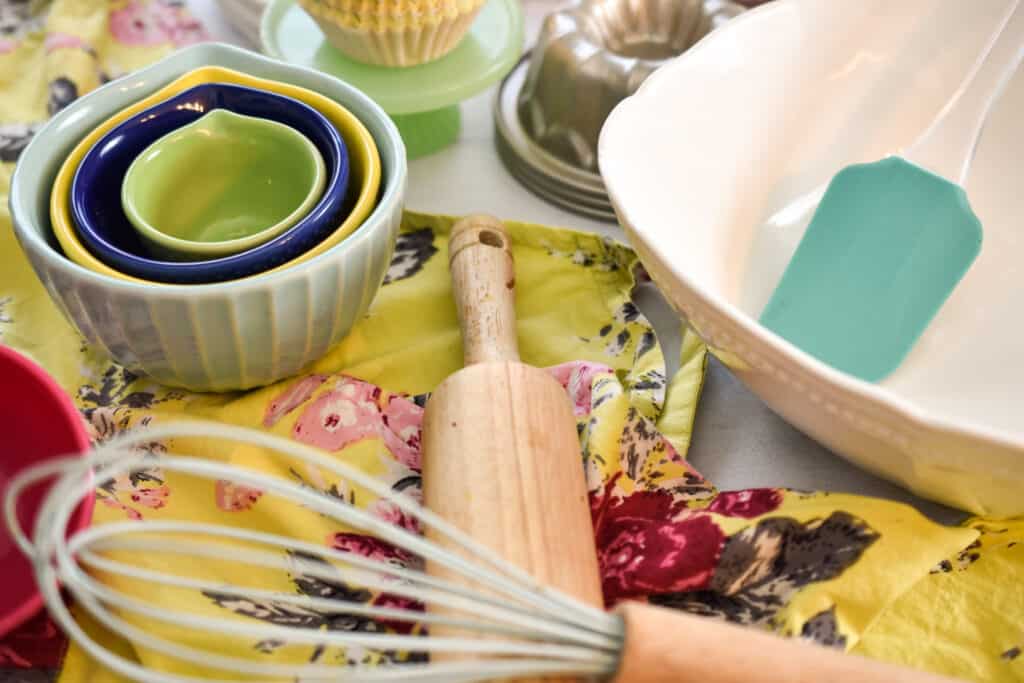
Allowing your ingredients to come to room temperature before baking is a must. Experienced bakers understand the importance of adequately softening butter and cream cheese.
If your ingredients are too cold, they will not blend into your food well and tend to clump up.
You'll notice that the majority of recipes call for your butter and sweetener to be creamed first. This is because it makes the process so much easier.
It's also good practice to allow your eggs to come to room temperature. And while I am talking about eggs, it's standard practice to use only large eggs when baking. Unless otherwise stated, you always want this size.
Letting your ingredients come to room temperature is standard practice in baking. However, keto baking is not a step you can skip.
If they are not soft enough, they simply will not be distributed evenly in the mix. This can have a significant effect on the outcome of your baked item.
You'll know if your butter and cream cheese are ready when they can be pressed easily but maintain their integrity. You can either let them come to room temperature or, in a pinch, microwave them for 10-15 seconds.
It's also important to have ingredients at the same temperature. For example, add hot ingredients to hot things and cold ingredients to cold things.
This is why it's not uncommon to see a recipe call for tempering a hot ingredient with a colder one. Doing so ensures that the mixture doesn't seize or separate.
I saw all this to say that having enough time for baking is crucial. This is why, when calculating the time it will take you to keto bake, consider the time your ingredients need to be ready.
Converting Your Recipes Into Keto Baked Recipes
It's possible to convert many of your favorite traditional baked goods, except yeast bread recipes. A yeast bread rises because it combines with the gluten in the wheat.
Note that no low-carb, keto or grain-free flours have gluten in them. This is why adding ¼ teaspoon more baking powder can also prove helpful and will raise the weight of the keto flour.
A good rule is to double the number of eggs called when converting your traditional baked recipes.
Something to remember is that in traditional baking, we are accustomed to scooping our wheat flour and then leveling off the excess.
Unfortunately, this will not work well with low-carb flour. Instead, add tablespoons of your flour alternatives into your measuring cups.
Replacing Milk In Keto Baking
At 12 grams of carbohydrates per cup, regular milk isn't low-carb or keto-friendly. When a recipe calls for milk, your best choices are unsweetened almond or coconut milk.
Alternatively, you can use heavy whipping cream by making a mixture of half whipping cream and half water to get a milk-like consistency.
Essential Kitchen Baking Tools
When it comes to baking keto or traditional, you need a few basic tools to ensure consistent results.
The following is my list of favorite baking tools:
- Measuring Cups and Spoons
- Stainless Steel Measuring Bowls
- Spatulas
- Whisks
- Baking Sheets
- Cake Pans
- Springform Pans
- Loaf Pans
- Silicone Baking Mats
- Rolling Pin
- Cooling Rack
- Cookie Scoops
- Hand Mixer
- Stand-up Mixer ( nice but not required)
Join Our Jesus And Keto Movement
Looking for an online support system to help you stay on keto? As a family, we came to the keto diet, looking at it from a Christian perspective. As believers, we live our lives supported by God's grace.
So when the Holy Spirit led us to combine our Christian faith and the keto diet, we did so in hopes of finding lasting transformation. When we followed the Holy Spirit's prompting, we got on the path to real transformation.
Knowing firsthand the benefits of this decision, we have created a closed Christian group that is using the keto diet to transform their lives.
We invite you to join our Private Facebook Group and see if it's not the key you have been missing.
Be sure to request our FREE Jesus and Keto E-Book (First 7 Days). We hope it blesses you.
Fittoservegroup Keto App
Looking for a fast way to access our keto recipes? We've got you covered. There's an app for that. Yup, there's a Fit To Serve Group App that will make your keto diet a delicious breeze!
Access hundreds of recipes that are all sugar-free, gluten-free, and keto-friendly.
Enjoy early access to recipes before they go live on the website. Plus, bonus recipes that are exclusive to the app. Make your own personal cookbooks that you can use to organize your favorite recipes.
Search recipes by title, ingredients, keywords, and categories, and of course, every recipe shows complete nutritional facts. Get the Fit to Serve Group App for easy-to-follow keto recipes made with easy-to-source ingredients.
The app is loaded with hundreds of yummy recipes for breakfast, lunch, dinner, snacks, and even desserts!
Learn more by visiting our Fit To Serve Group App Page.




